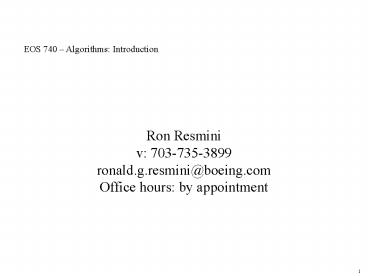EOS 740 Algorithms: Introduction - PowerPoint PPT Presentation
1 / 34
Title:
EOS 740 Algorithms: Introduction
Description:
SMA/OSP/DSR/CEM. Derivative Spectroscopy/ other Parameterization ... Caveat emptor... lots of reproduction of work already accomplished. who invented what? ... – PowerPoint PPT presentation
Number of Views:149
Avg rating:3.0/5.0
Title: EOS 740 Algorithms: Introduction
1
EOS 740 Algorithms Introduction
Ron Resmini v 703-735-3899 ronald.g.resmini_at_boein
g.com Office hours by appointment
2
- Algorithm "classes"/overview
- Distance Metrics
- Angular Metric
- SMA/OSP/DSR/CEM
- Derivative Spectroscopy/other Parameterization
Methods - Spectra in hyperspace
- Some real scatter plots
- Use ENVI to view scatter plots
3
- Real data show very complicatedscatter plots
- blobs, elongated blobs, etc...
- binary, ternary mixing trends
4
- Whole pixel/single-pixel, non-statistical
distance metrics - Distance between points (spectra) in hyperspace
- Spectra as vectors
- Absolute difference/absolute difference squared
- Derivative difference/derivative difference
squared - Euclidean distance
- Relative difference
- BE/Hamming distance
- There are others, too...
- ENVI...
- Application strategies (i.e., in-scene
spectra/library spectra) - Mixed pixels...
5
- Spectra as vectors
- Angular separation of vectors (spectra)
- Spectral Angle Mapper (SAM)
- Invariant to albedo
- Running SAM in ENVI
- Application strategies(i.e., in-scene
spectra/library spectra) - Mixed pixels...and SAM...
6
- Statistical distance metrics
- (essentially preprocessing for supervisedclassifi
cation) - Minimum distance
- Mahalanobis distance
- Maximum likelihood distance
- Parallelpiped
- Jeffries-Matusita distance/Bhattacharyya distance
- Spectral divergence
- Other...
- Application strategies (i.e., in-scene spectra)
- Mixed pixels...
7
Minimum Distance
Mahalanobis Distance
Maximum Likelihood
8
Jeffries-Matusita (JM) Distance
Where B is the Bhattacharyya distance
9
- The mixed pixel
- a basis concept a very important
conceptdescription of a mixed pixel - determining quantity of material
- building a mixed pixel - spectral math
- building a mixed pixel - MS Excel
- mixing trends in hyperspace
10
- Linear spectral mixture analysis
- applications
- scene characterization
- material mapping
- anomaly detection
- other...
11
- Endmember selection
- manual
- convex hull
- Pixel-Purity Index (PPI)
- adaptive/updating/pruning...
- other (e.g., N-FINDR, ORASIS,URSSA, etc...)
- wild outliers
12
- Unmixing inversion
- interpretation of results
- RMS, RSS, algebraic and geometricinterpretations
- are RMS, RSS, etc. the best measures?
- residual correlation analysis (RCA)
- band residual cube
- can we build a band residual cubewith ENVI?
13
- iterative process
- the inversion in Matlab a closer lookat the
math - fraction-plane color-composites
- change detection with fraction planes
- constraints on inversion
- is it a linear mixture?
14
- application strategies (i.e., in-scenespectra/lib
rary spectra) - directed search? anomaly detection?
- Shade/shadow
- shade endmember
- shade removal
- Other...
- objective endmember determinationTompkins et al.
15
- Non-linear spectral mixture analysis
- checker-board mixtures
- intimate mixtures
- building a non-linear mixture
- spectral transformations (e.g., SSA)and use of
ENVI
16
A linear equation...
x
A
b
5 endmembers in a 7-band spectral data set
17
Prelude to Other Algorithms Statistical Spectral
Matched Filters OSP OBS
- Orthogonal Subspace Projection (OSP)
- Derivation in detail (next several slides...)
- Application of the filter
- Endmembers
- Statistics
- Interpretation of results
- OSP w/endmembers unconstrained SMA
- Different ways to apply the filter/application
strategies(i.e., in-scene spectra/library
spectra)
18
OSP/LPD/DSR Scene-Derived Endmembers
(Harsanyi et al., 1994)
19
(No Transcript)
20
(No Transcript)
21
The value of xT which maximizes l is given by xT
dT
This is equivalent to Unconstrained SMA
22
Statistical Characterization of the
Background (LPD/DSR)
(Harsanyi et al., 1994)
23
(No Transcript)
24
- The statistical spectral matched filter (SSMF)
- Derivation in detail
- Application of the filter
- Statistics
- Endmembers (FBA/MCEM)
- Interpretation of results
- Many algorithms are actually the basic SSMF
- Different ways to apply the filter/application
strategies(i.e., in-scene spectra/library
spectra) - Matched filter in ENVI
25
Constrained Energy Minimization (CEM)
(Harsanyi et al., 1994)
26
(No Transcript)
27
An Endnote...
- Previous techniques exploit shape and albedo
- this can cause problems...
- Sub-classes of algorithms developed to mitigate
this - shape, only, operators
- MED, RSD of ASIT, Inc.
- MTMF of ENVI (ITT/RSI)
28
Last Class of Algorithms
- Spectral feature fitting/derivative spectroscopy
- Spectral parameterizations
- Wavelets
- Band depth/band depth mapping
- Application strategies (i.e., in-scenespectra/lib
rary spectra) - Mixed pixels...
29
Another Endnote...
- Performance prediction/scoring/NP-Theory, etc...
- Hybrid techniques
- still some cream to be skimmed...
- Caveat emptor...
- lots of reproduction of work already accomplished
- who invented what? when?
- waste of resources
- please do your homework!read the lit.!
30
- References/Resources
- Books
- Journals
- ATBDs (MODIS, other)
- SPIE, IEEE, other
31
Backup Slides
32
Lagrange Multiplier Derivation of CEM Filter
Minimizing E is equivalent to minimizing each yi2
(for k 1, 2, 3, ... )
33
In Matrix Notation
34
(No Transcript)































